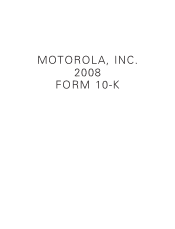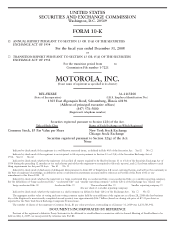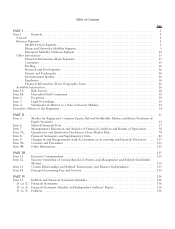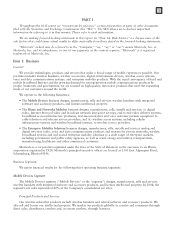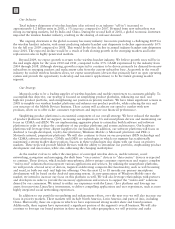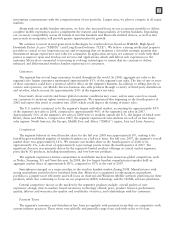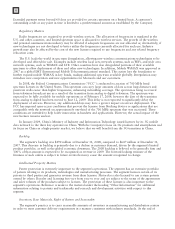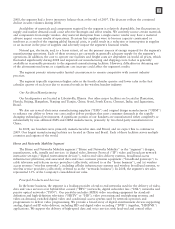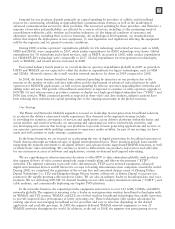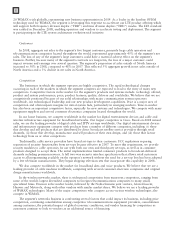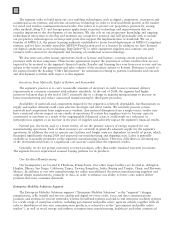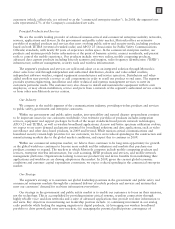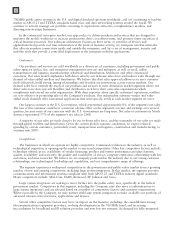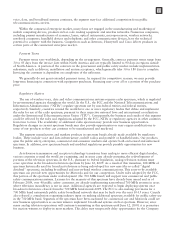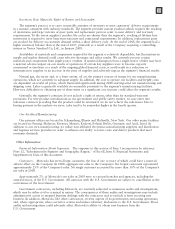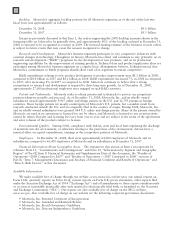Motorola 2008 Annual Report Download - page 15
Download and view the complete annual report
Please find page 15 of the 2008 Motorola annual report below. You can navigate through the pages in the report by either clicking on the pages listed below, or by using the keyword search tool below to find specific information within the annual report.
Demand for our products depends primarily on capital spending by providers of cellular and broadband
services for constructing, rebuilding or upgrading their communications systems, as well as the marketing of
advanced communications services by those providers. The amount of spending by these providers, and therefore a
majority of our sales and profitability, are affected by a variety of factors, including: (i) the continuing trend of
consolidation within the cable, wireline and wireless industries, (ii) the financial condition of operators and
alternative providers, including their access to financing, (iii) technological developments, (iv) standardization
efforts that impact the deployment of new equipment, (v) new legislation and regulations affecting the equipment
sold by the segment, and (vi) general economic conditions.
During 2008, wireless operators’ expenditures globally for 2G technology and related services, such as GSM,
GPRS and EDGE, were comparable to 2007, while similar expenditures for iDEN technology were down. Global
expenditures for 3G technology and related services, such as UMTS, increased in 2008, while similar expenditures
for CDMA/EV-DO technology were comparable to 2007. Global expenditures for next-generation technologies,
such as WiMAX, and related services increased in 2008.
Forecasted industry trends point to an overall decline in operator expenditures globally in 2009, as growth in
UMTS and WiMAX are not expected to offset the decline in expenditures for legacy technologies, such as GSM
and CDMA. Motorola expects the overall wireless network market to be down in 2009 compared to 2008.
In 2008, the home business benefited from continued spending by operators on our products due to the
increase in the number of video and data subscribers and the deployment of advanced video platforms by cable
operators for HD/DVR applications, as well as from spending by telecom operators upgrading their networks and
adding video services. The growth of broadband connectivity is expected to continue as cable operators upgrade to
DOCSIS 3.0 and telecom service providers continue to deploy very high speed digital subscriber line (“VDSL”) and
PON data services. While continued growth is expected in these video and data markets, industry analysts have
been reducing their outlooks for capital spending due to the ongoing uncertainty in the global economy.
Our Strategy
The Home and Networks Mobility segment is focused on leadership in next-generation broadband solutions
to accelerate the delivery of personal media experiences. Key elements in the segment’s strategy include:
(i) providing for seamless convergence of services and applications across delivery platforms within the home and
across wireline and wireless networks, (ii) innovating and optimizing our end-to-end network portfolio, and
(iii) developing new services that leverage our platforms to provide revenue generating applications and services to
our operator customers while enabling consumers to experience media mobility. As part of our strategy, we have
made and will continue to make strategic acquisitions.
In the home business, we are focused on accelerating the rate of digital penetration by broadband operators in
North America through an enhanced suite of digital entertainment devices. These products include basic models
supporting the industry movement to all-digital delivery and advanced units supporting HD/DVR functions, as well
as whole home video networking. We continue to invest to differentiate our products and services and add value
for our customers in areas of software and applications, content on-demand and targeted advertising.
We are capitalizing on telecom operators decisions to offer IPTV to their subscribers globally, with products
that support delivery of video content using both copper-outside-plant and fiber-to-the-premises (“FTTP”)
networks. The segment continues to provide video infrastructure, FTTP access network equipment, advanced
digital entertainment devices and IP interactive set-tops to leading telecommunication companies around the world.
During 2008, we completed the acquisition of the set-top box and associated chipset assets of Zhejung Dahua
Digital Technology Co., LTD and Hangzhou Image Silicon, known collectively as Dahua Digital to increase our
position in the rapidly growing cable market in China. We are also an industry leader in broadband data and voice
products. We are delivering DOCSIS 3.0 channel bonding on our cable modem termination systems (“CMTS”) and
cable modems, and commercially deploying our Gigabit PON platform.
In the networks business, the segment provides equipment and services to over 125 GSM, CDMA, and iDEN
networks globally. The segment is investing to be a leader in next-generation wireless broadband technologies with
its WiMAX and LTE systems. WiMAX and LTE are evolved wireless broadband technologies that enable operators
to provide improved data performance at lower operating cost. These technologies offer similar advantages for
existing operators and emerging broadband service providers and vary in selection depending on the desired
application and available spectrum. In 2008, the segment delivered WiMAX network equipment to over 25
WiMAX networks throughout the world. In addition, at the end of 2008, the segment was participating in over
7


